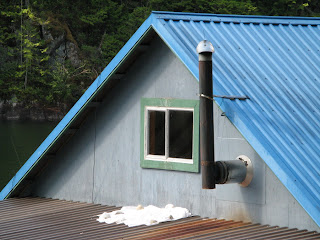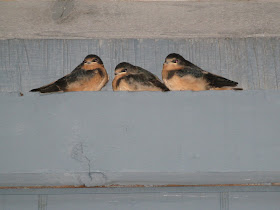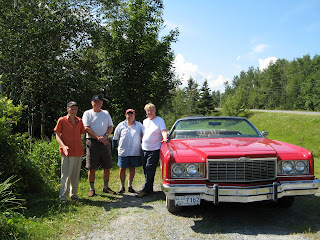
Looks like fall is coming early this year. Typically, it's October before
Mr. Woodrat appears. That brings to mind a funny story I call "The Night of the Woodrat." The second year we had our float cabin, I was able to go up the lake by myself the week before Thanksgiving. Even though I grew up in Los Angeles, I had lots of experience outdoors and camping. I was confident my solo trip would be a piece of cake.
Sleeping upstairs in the cabin's loft is usually peaceful and quiet. I built a fire in the wood stove to keep warm and turned in early to read. Before long, I drifted off, only to be roused by a racket downstairs. I keep a flashlight next to the bed, so I grabbed it and looked over the railing. At first there was no sound and nothing in sight. Then the quick scurrying of little feet caught my attention and a small furry critter scampered out of the darkness to appear at the foot of the stairs. There, as bold as could be, staring up at me was a woodrat (packrat). His large dark eyes and perky round ears were inquisitive, and his bushy tail twitched up and down with excitement. Now I must admit, as comfortable as I am with nature, sleeping in confined quarters with a small rodent isn't high on my bucket list.

My first thought was, how in the world did he get indoors. My second thought was, how in the world was I going to get him back outdoors. I cautiously climbed downstairs and opened the sliding glass door. Of course, he didn't cooperate and exit on cue. I tried chasing him, but he avoided going anywhere near the door. Then I thought I was so smart. I piled firewood into a barricade to encourage him out on his next circuit of the living room wall. I tiptoed behind and chased him back towards the open door. But he ran right on past and over the wall like an Olympic high jumper. By now I was pretty tired and exasperated. On his next pass from the kitchen back to living room, he stopped at the wood stove, dove underneath and up inside. That did it. I left the sliding door open and went back to bed. I figured if he wanted to be indoors that bad, I could share my abode for one night.
The next morning there was no sign of Mr. Woodrat. I'm sure he wasn't a dream (nightmare?) because the sliding glass door was open, it was a chilly 10 degrees inside, and there was firewood stacked in a tall pile leading to the doorway.

Each year, Mr. (or Mrs.) Woodrat has returned when there gets to be a chill in the evening air and the leaves begin to turn. He hasn't come inside again, but loves to harvest my flowers and vegetables for his winter stores. He also likes to set up house in our wood shed. Neither of these activities are appreciated, so we use our
Havahart live trap to catch and relocate our occasional bushy-tailed visitors. Last year there were three. So far this year, the count is one. Hopefully it will be the last. -- Margy
 Each year we take our 24' Bayliner out of the chuck (ocean) and bring her up the lake for a winter in fresh water. There are several advantages in doing this. The fresh water is good for the hull and every other exposed and internal part, the growth of algae and sea critters is brought to a screeching halt, and we have a bigger boat for lake cruises and for an added measure of safety during rough winter water.
Each year we take our 24' Bayliner out of the chuck (ocean) and bring her up the lake for a winter in fresh water. There are several advantages in doing this. The fresh water is good for the hull and every other exposed and internal part, the growth of algae and sea critters is brought to a screeching halt, and we have a bigger boat for lake cruises and for an added measure of safety during rough winter water. This weekend we took the Bayliner for a summer cruise to the head of Powell Lake. Powell Lake is a glacial carved fjord that is 51 kilometres (32 miles) long with 480 kilometres (300 miles) of shoreline. From our cabin at Hole in the Wall it about 36 kilometres (22 miles) to the head. Our first stop was the logging dock. We hiked through the log sort and found it full of fresh cut trees ready to be dumped into the lake for transport. We were surprised to see so much action because of the summer and economic slowdown.
This weekend we took the Bayliner for a summer cruise to the head of Powell Lake. Powell Lake is a glacial carved fjord that is 51 kilometres (32 miles) long with 480 kilometres (300 miles) of shoreline. From our cabin at Hole in the Wall it about 36 kilometres (22 miles) to the head. Our first stop was the logging dock. We hiked through the log sort and found it full of fresh cut trees ready to be dumped into the lake for transport. We were surprised to see so much action because of the summer and economic slowdown. Next we passed through the camp built by Plutonic Power to support the construction of hydro lines from their run-of-river project in the Toba Valley. We continued up the logging road to the bridge that spans the Daniels River. During dry summer months, this is the main source of water for the lake. As you can see from the exposed stumps, the input isn't keeping up with evaporation and the outflow at the dam.
Next we passed through the camp built by Plutonic Power to support the construction of hydro lines from their run-of-river project in the Toba Valley. We continued up the logging road to the bridge that spans the Daniels River. During dry summer months, this is the main source of water for the lake. As you can see from the exposed stumps, the input isn't keeping up with evaporation and the outflow at the dam. We then took the Bayliner to the east side of the large bay and anchored where we would catch the last rays of the setting sun. There aren't many places on this steep sided lake where you can anchor, but we found one near Jim Brown Creek. We lowered Mr. Bathtub (our dinghy) and paddled to shore for a hike up another logging road. On the way we found tracks from elk reintroduced here last year. It's good to see they are flourishing in the lush environment.
We then took the Bayliner to the east side of the large bay and anchored where we would catch the last rays of the setting sun. There aren't many places on this steep sided lake where you can anchor, but we found one near Jim Brown Creek. We lowered Mr. Bathtub (our dinghy) and paddled to shore for a hike up another logging road. On the way we found tracks from elk reintroduced here last year. It's good to see they are flourishing in the lush environment. After a refreshing swim, we headed back for a shipboard BBQ of chicken and sausages. And boy was I hungry. The weather was warm and calm all night. Just a gentle rock and lapping sound on the hull. On our way back home in the morning, we saw lots of people enjoying the lake. Some were at their cabins, others camping along the shore. There's still a bit of summer left, so why don't you join Wayne and I up the lake. -- Margy
After a refreshing swim, we headed back for a shipboard BBQ of chicken and sausages. And boy was I hungry. The weather was warm and calm all night. Just a gentle rock and lapping sound on the hull. On our way back home in the morning, we saw lots of people enjoying the lake. Some were at their cabins, others camping along the shore. There's still a bit of summer left, so why don't you join Wayne and I up the lake. -- Margy












































